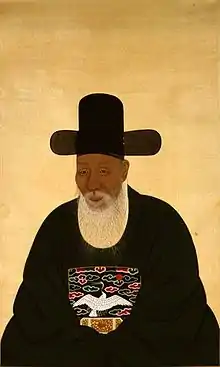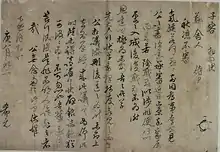Gim Jangsaeng
Gim Jangsaeng (July 8, 1548 - August 3, 1631) was a Neo-Confucian scholar, politician, educator, and writer of Korea's Joseon period.[1]
| Gim Jangsaeng | |
 | |
| Korean name | |
|---|---|
| Hangul | 김장생 |
| Hanja | |
| Revised Romanization | Gim Jangsaeng |
| McCune–Reischauer | Kim Changsaeng |
| Pen name | |
| Hangul | 사계 |
| Hanja | |
| Revised Romanization | Sagye |
| McCune–Reischauer | Sagye |
| Courtesy name | |
| Hangul | 희원, 희지 |
| Hanja | |
| Revised Romanization | Huiwon, Huiji |
| McCune–Reischauer | Hŭiwŏn, Huiji |

Letter of Gim Jangsaeng
He was successor to the Neo-Confucian academic tradition of Yulgok Yi I (이이) and Seong Hon (성혼).
See also
References
- Jae-eun Kang The Land of Scholars: Two Thousand Years of Korean Confucianism 2006 "A pioneer of the study on family rites based on the doctrines of Zhu Xi in Joseon was Gim Jangsaeng (金長生, pen name is Sagye 沙溪, 1548-1631), who wrote Garye jimnam (家禮輯覽, Exposition of Family Rites) and belonged to the Giho ..."
- Daehwan, Noh. "The Eclectic Development of Neo-Confucianism and Statecraft from the 18th to the 19th Century," Korea Journal. Winter 2003.
- Haboush, JaHyun Kim and Martina Deuchler. (1999). Culture and the State in Late Chosŏn Korea. Cambridge: Harvard University Press. ISBN 9780674179820; OCLC 40926015
- Lee, Peter H. (1993). Sourcebook of Korean Civilization, Vol. 1. New York: Columbia University Press. ISBN 9780231079129; ISBN 9780231079143; ISBN 9780231104449; OCLC 26353271
This article is issued from Wikipedia. The text is licensed under Creative Commons - Attribution - Sharealike. Additional terms may apply for the media files.